2006 CHEVROLET SILVERADO wheel
[x] Cancel search: wheelPage 384 of 594
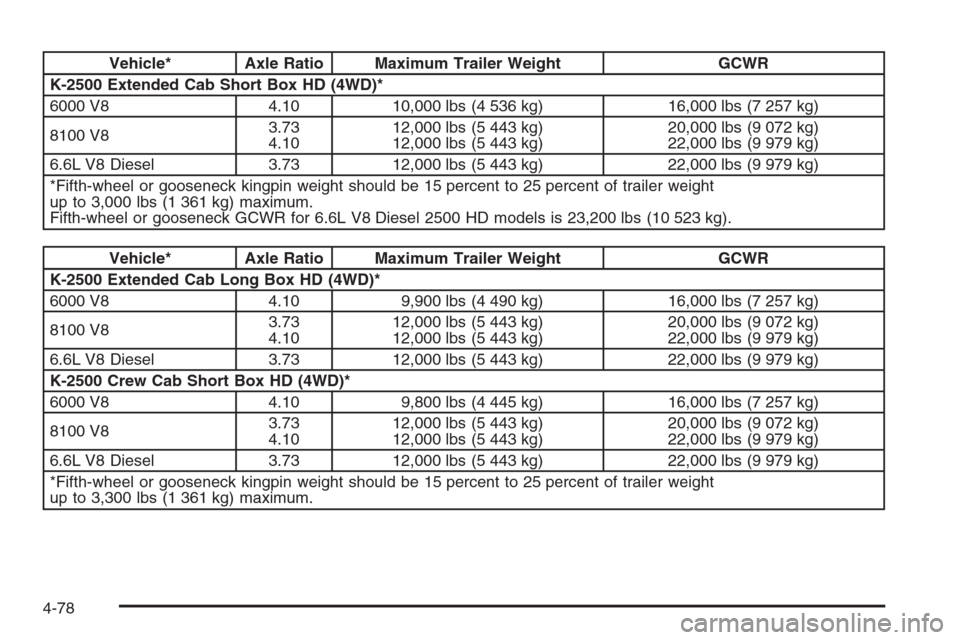
Vehicle* Axle Ratio Maximum Trailer Weight GCWR
K-2500 Extended Cab Short Box HD (4WD)*
6000 V8 4.10 10,000 lbs (4 536 kg) 16,000 lbs (7 257 kg)
8100 V83.73
4.1012,000 lbs (5 443 kg)
12,000 lbs (5 443 kg)20,000 lbs (9 072 kg)
22,000 lbs (9 979 kg)
6.6L V8 Diesel 3.73 12,000 lbs (5 443 kg) 22,000 lbs (9 979 kg)
*Fifth-wheel or gooseneck kingpin weight should be 15 percent to 25 percent of trailer weight
up to 3,000 lbs (1 361 kg) maximum.
Fifth-wheel or gooseneck GCWR for 6.6L V8 Diesel 2500 HD models is 23,200 lbs (10 523 kg).
Vehicle* Axle Ratio Maximum Trailer Weight GCWR
K-2500 Extended Cab Long Box HD (4WD)*
6000 V8 4.10 9,900 lbs (4 490 kg) 16,000 lbs (7 257 kg)
8100 V83.73
4.1012,000 lbs (5 443 kg)
12,000 lbs (5 443 kg)20,000 lbs (9 072 kg)
22,000 lbs (9 979 kg)
6.6L V8 Diesel 3.73 12,000 lbs (5 443 kg) 22,000 lbs (9 979 kg)
K-2500 Crew Cab Short Box HD (4WD)*
6000 V8 4.10 9,800 lbs (4 445 kg) 16,000 lbs (7 257 kg)
8100 V83.73
4.1012,000 lbs (5 443 kg)
12,000 lbs (5 443 kg)20,000 lbs (9 072 kg)
22,000 lbs (9 979 kg)
6.6L V8 Diesel 3.73 12,000 lbs (5 443 kg) 22,000 lbs (9 979 kg)
*Fifth-wheel or gooseneck kingpin weight should be 15 percent to 25 percent of trailer weight
up to 3,300 lbs (1 361 kg) maximum.
4-78
Page 385 of 594
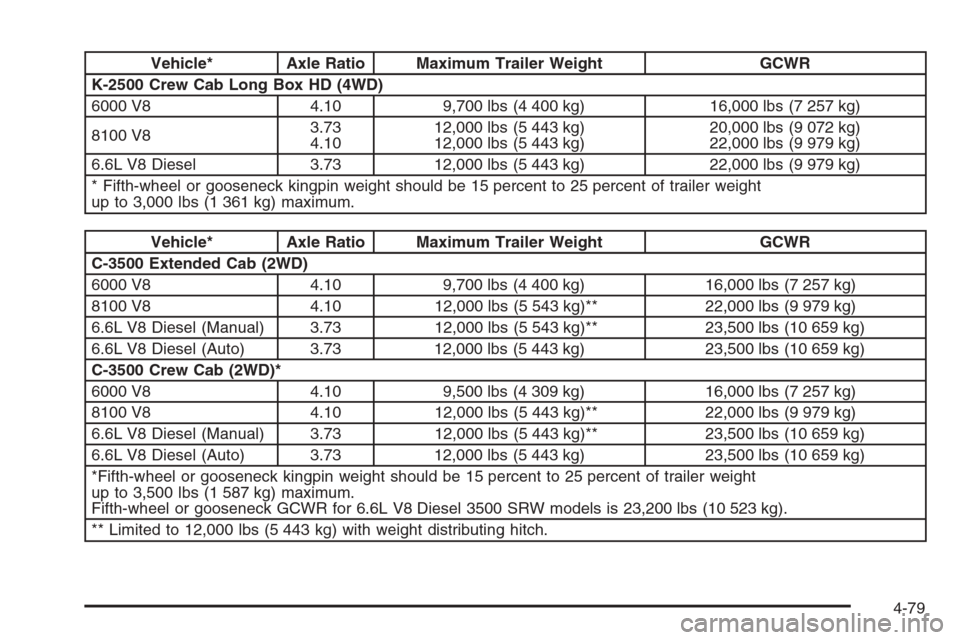
Vehicle* Axle Ratio Maximum Trailer Weight GCWR
K-2500 Crew Cab Long Box HD (4WD)
6000 V8 4.10 9,700 lbs (4 400 kg) 16,000 lbs (7 257 kg)
8100 V83.73
4.1012,000 lbs (5 443 kg)
12,000 lbs (5 443 kg)20,000 lbs (9 072 kg)
22,000 lbs (9 979 kg)
6.6L V8 Diesel 3.73 12,000 lbs (5 443 kg) 22,000 lbs (9 979 kg)
* Fifth-wheel or gooseneck kingpin weight should be 15 percent to 25 percent of trailer weight
up to 3,000 lbs (1 361 kg) maximum.
Vehicle* Axle Ratio Maximum Trailer Weight GCWR
C-3500 Extended Cab (2WD)
6000 V8 4.10 9,700 lbs (4 400 kg) 16,000 lbs (7 257 kg)
8100 V8 4.10 12,000 lbs (5 543 kg)** 22,000 lbs (9 979 kg)
6.6L V8 Diesel (Manual) 3.73 12,000 lbs (5 543 kg)** 23,500 lbs (10 659 kg)
6.6L V8 Diesel (Auto) 3.73 12,000 lbs (5 443 kg) 23,500 lbs (10 659 kg)
C-3500 Crew Cab (2WD)*
6000 V8 4.10 9,500 lbs (4 309 kg) 16,000 lbs (7 257 kg)
8100 V8 4.10 12,000 lbs (5 443 kg)** 22,000 lbs (9 979 kg)
6.6L V8 Diesel (Manual) 3.73 12,000 lbs (5 443 kg)** 23,500 lbs (10 659 kg)
6.6L V8 Diesel (Auto) 3.73 12,000 lbs (5 443 kg) 23,500 lbs (10 659 kg)
*Fifth-wheel or gooseneck kingpin weight should be 15 percent to 25 percent of trailer weight
up to 3,500 lbs (1 587 kg) maximum.
Fifth-wheel or gooseneck GCWR for 6.6L V8 Diesel 3500 SRW models is 23,200 lbs (10 523 kg).
** Limited to 12,000 lbs (5 443 kg) with weight distributing hitch.
4-79
Page 386 of 594
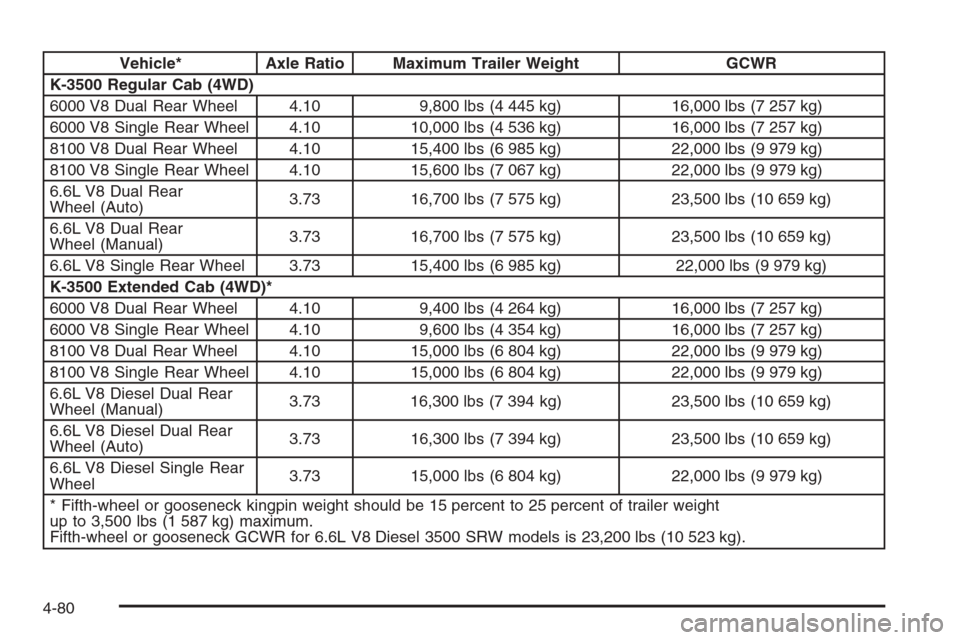
Vehicle* Axle Ratio Maximum Trailer Weight GCWR
K-3500 Regular Cab (4WD)
6000 V8 Dual Rear Wheel 4.10 9,800 lbs (4 445 kg) 16,000 lbs (7 257 kg)
6000 V8 Single Rear Wheel 4.10 10,000 lbs (4 536 kg) 16,000 lbs (7 257 kg)
8100 V8 Dual Rear Wheel 4.10 15,400 lbs (6 985 kg) 22,000 lbs (9 979 kg)
8100 V8 Single Rear Wheel 4.10 15,600 lbs (7 067 kg) 22,000 lbs (9 979 kg)
6.6L V8 Dual Rear
Wheel (Auto)3.73 16,700 lbs (7 575 kg) 23,500 lbs (10 659 kg)
6.6L V8 Dual Rear
Wheel (Manual)3.73 16,700 lbs (7 575 kg) 23,500 lbs (10 659 kg)
6.6L V8 Single Rear Wheel 3.73 15,400 lbs (6 985 kg) 22,000 lbs (9 979 kg)
K-3500 Extended Cab (4WD)*
6000 V8 Dual Rear Wheel 4.10 9,400 lbs (4 264 kg) 16,000 lbs (7 257 kg)
6000 V8 Single Rear Wheel 4.10 9,600 lbs (4 354 kg) 16,000 lbs (7 257 kg)
8100 V8 Dual Rear Wheel 4.10 15,000 lbs (6 804 kg) 22,000 lbs (9 979 kg)
8100 V8 Single Rear Wheel 4.10 15,000 lbs (6 804 kg) 22,000 lbs (9 979 kg)
6.6L V8 Diesel Dual Rear
Wheel (Manual)3.73 16,300 lbs (7 394 kg) 23,500 lbs (10 659 kg)
6.6L V8 Diesel Dual Rear
Wheel (Auto)3.73 16,300 lbs (7 394 kg) 23,500 lbs (10 659 kg)
6.6L V8 Diesel Single Rear
Wheel3.73 15,000 lbs (6 804 kg) 22,000 lbs (9 979 kg)
* Fifth-wheel or gooseneck kingpin weight should be 15 percent to 25 percent of trailer weight
up to 3,500 lbs (1 587 kg) maximum.
Fifth-wheel or gooseneck GCWR for 6.6L V8 Diesel 3500 SRW models is 23,200 lbs (10 523 kg).
4-80
Page 387 of 594
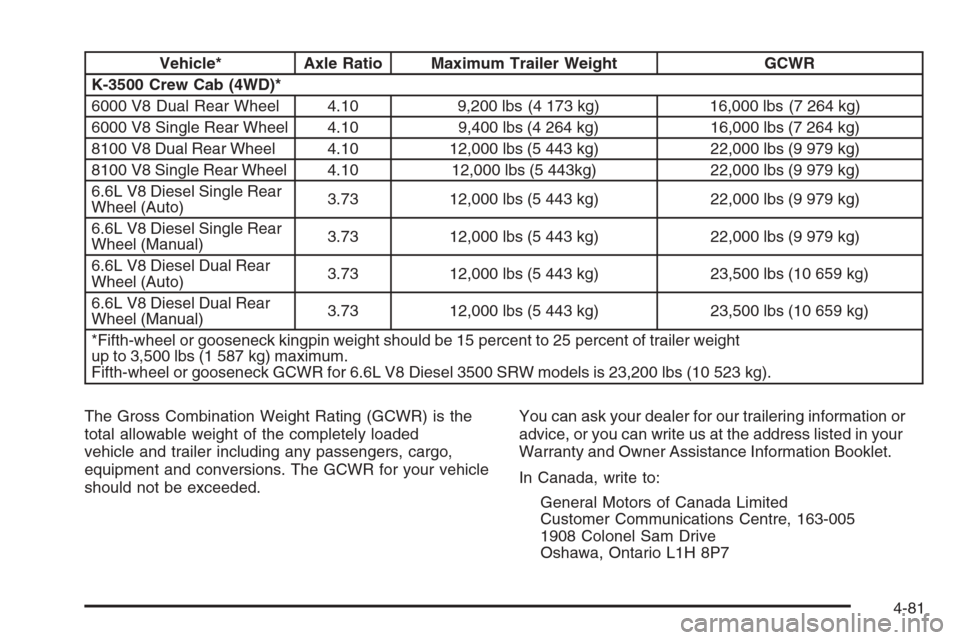
Vehicle* Axle Ratio Maximum Trailer Weight GCWR
K-3500 Crew Cab (4WD)*
6000 V8 Dual Rear Wheel 4.10 9,200 lbs (4 173 kg) 16,000 lbs (7 264 kg)
6000 V8 Single Rear Wheel 4.10 9,400 lbs (4 264 kg) 16,000 lbs (7 264 kg)
8100 V8 Dual Rear Wheel 4.10 12,000 lbs (5 443 kg) 22,000 lbs (9 979 kg)
8100 V8 Single Rear Wheel 4.10 12,000 lbs (5 443kg) 22,000 lbs (9 979 kg)
6.6L V8 Diesel Single Rear
Wheel (Auto)3.73 12,000 lbs (5 443 kg) 22,000 lbs (9 979 kg)
6.6L V8 Diesel Single Rear
Wheel (Manual)3.73 12,000 lbs (5 443 kg) 22,000 lbs (9 979 kg)
6.6L V8 Diesel Dual Rear
Wheel (Auto)3.73 12,000 lbs (5 443 kg) 23,500 lbs (10 659 kg)
6.6L V8 Diesel Dual Rear
Wheel (Manual)3.73 12,000 lbs (5 443 kg) 23,500 lbs (10 659 kg)
*Fifth-wheel or gooseneck kingpin weight should be 15 percent to 25 percent of trailer weight
up to 3,500 lbs (1 587 kg) maximum.
Fifth-wheel or gooseneck GCWR for 6.6L V8 Diesel 3500 SRW models is 23,200 lbs (10 523 kg).
The Gross Combination Weight Rating (GCWR) is the
total allowable weight of the completely loaded
vehicle and trailer including any passengers, cargo,
equipment and conversions. The GCWR for your vehicle
should not be exceeded.You can ask your dealer for our trailering information or
advice, or you can write us at the address listed in your
Warranty and Owner Assistance Information Booklet.
In Canada, write to:
General Motors of Canada Limited
Customer Communications Centre, 163-005
1908 Colonel Sam Drive
Oshawa, Ontario L1H 8P7
4-81
Page 388 of 594
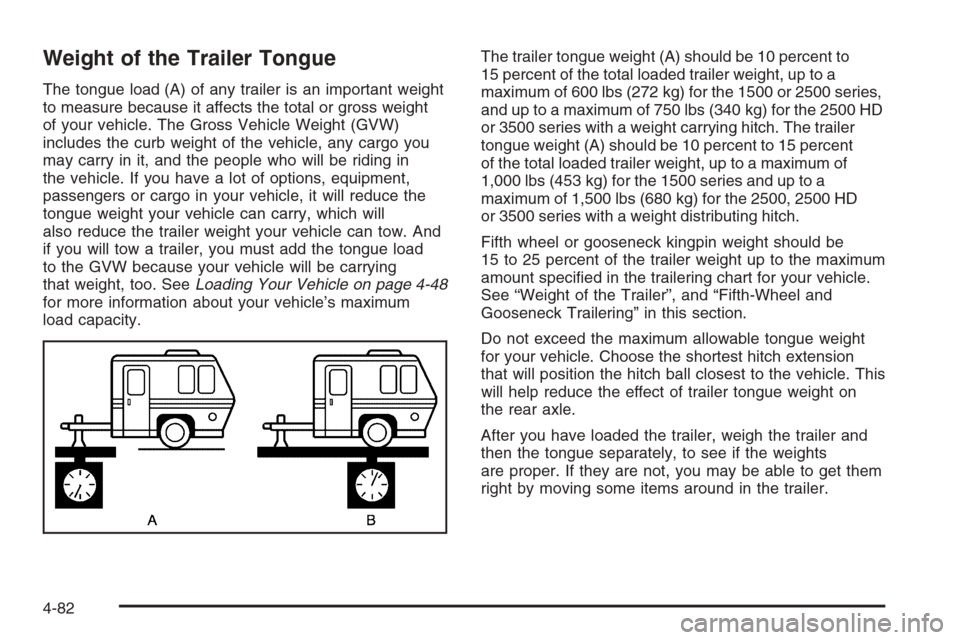
Weight of the Trailer Tongue
The tongue load (A) of any trailer is an important weight
to measure because it affects the total or gross weight
of your vehicle. The Gross Vehicle Weight (GVW)
includes the curb weight of the vehicle, any cargo you
may carry in it, and the people who will be riding in
the vehicle. If you have a lot of options, equipment,
passengers or cargo in your vehicle, it will reduce the
tongue weight your vehicle can carry, which will
also reduce the trailer weight your vehicle can tow. And
if you will tow a trailer, you must add the tongue load
to the GVW because your vehicle will be carrying
that weight, too. SeeLoading Your Vehicle on page 4-48
for more information about your vehicle’s maximum
load capacity.The trailer tongue weight (A) should be 10 percent to
15 percent of the total loaded trailer weight, up to a
maximum of 600 lbs (272 kg) for the 1500 or 2500 series,
and up to a maximum of 750 lbs (340 kg) for the 2500 HD
or 3500 series with a weight carrying hitch. The trailer
tongue weight (A) should be 10 percent to 15 percent
of the total loaded trailer weight, up to a maximum of
1,000 lbs (453 kg) for the 1500 series and up to a
maximum of 1,500 lbs (680 kg) for the 2500, 2500 HD
or 3500 series with a weight distributing hitch.
Fifth wheel or gooseneck kingpin weight should be
15 to 25 percent of the trailer weight up to the maximum
amount speci�ed in the trailering chart for your vehicle.
See “Weight of the Trailer”, and “Fifth-Wheel and
Gooseneck Trailering” in this section.
Do not exceed the maximum allowable tongue weight
for your vehicle. Choose the shortest hitch extension
that will position the hitch ball closest to the vehicle. This
will help reduce the effect of trailer tongue weight on
the rear axle.
After you have loaded the trailer, weigh the trailer and
then the tongue separately, to see if the weights
are proper. If they are not, you may be able to get them
right by moving some items around in the trailer.
4-82
Page 391 of 594
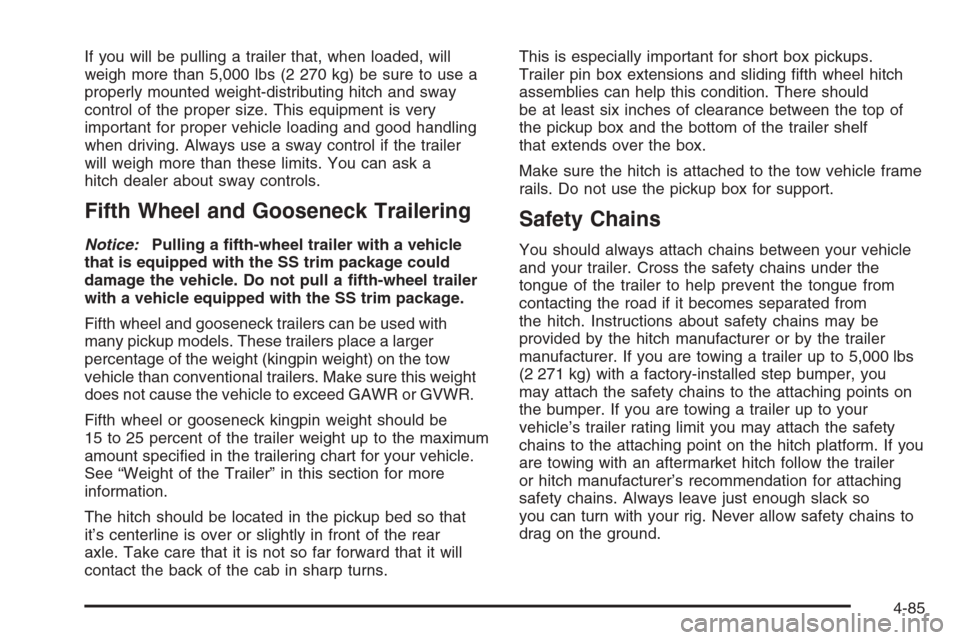
If you will be pulling a trailer that, when loaded, will
weigh more than 5,000 lbs (2 270 kg) be sure to use a
properly mounted weight-distributing hitch and sway
control of the proper size. This equipment is very
important for proper vehicle loading and good handling
when driving. Always use a sway control if the trailer
will weigh more than these limits. You can ask a
hitch dealer about sway controls.
Fifth Wheel and Gooseneck Trailering
Notice:Pulling a �fth-wheel trailer with a vehicle
that is equipped with the SS trim package could
damage the vehicle. Do not pull a �fth-wheel trailer
with a vehicle equipped with the SS trim package.
Fifth wheel and gooseneck trailers can be used with
many pickup models. These trailers place a larger
percentage of the weight (kingpin weight) on the tow
vehicle than conventional trailers. Make sure this weight
does not cause the vehicle to exceed GAWR or GVWR.
Fifth wheel or gooseneck kingpin weight should be
15 to 25 percent of the trailer weight up to the maximum
amount speci�ed in the trailering chart for your vehicle.
See “Weight of the Trailer” in this section for more
information.
The hitch should be located in the pickup bed so that
it’s centerline is over or slightly in front of the rear
axle. Take care that it is not so far forward that it will
contact the back of the cab in sharp turns.This is especially important for short box pickups.
Trailer pin box extensions and sliding �fth wheel hitch
assemblies can help this condition. There should
be at least six inches of clearance between the top of
the pickup box and the bottom of the trailer shelf
that extends over the box.
Make sure the hitch is attached to the tow vehicle frame
rails. Do not use the pickup box for support.
Safety Chains
You should always attach chains between your vehicle
and your trailer. Cross the safety chains under the
tongue of the trailer to help prevent the tongue from
contacting the road if it becomes separated from
the hitch. Instructions about safety chains may be
provided by the hitch manufacturer or by the trailer
manufacturer. If you are towing a trailer up to 5,000 lbs
(2 271 kg) with a factory-installed step bumper, you
may attach the safety chains to the attaching points on
the bumper. If you are towing a trailer up to your
vehicle’s trailer rating limit you may attach the safety
chains to the attaching point on the hitch platform. If you
are towing with an aftermarket hitch follow the trailer
or hitch manufacturer’s recommendation for attaching
safety chains. Always leave just enough slack so
you can turn with your rig. Never allow safety chains to
drag on the ground.
4-85
Page 393 of 594
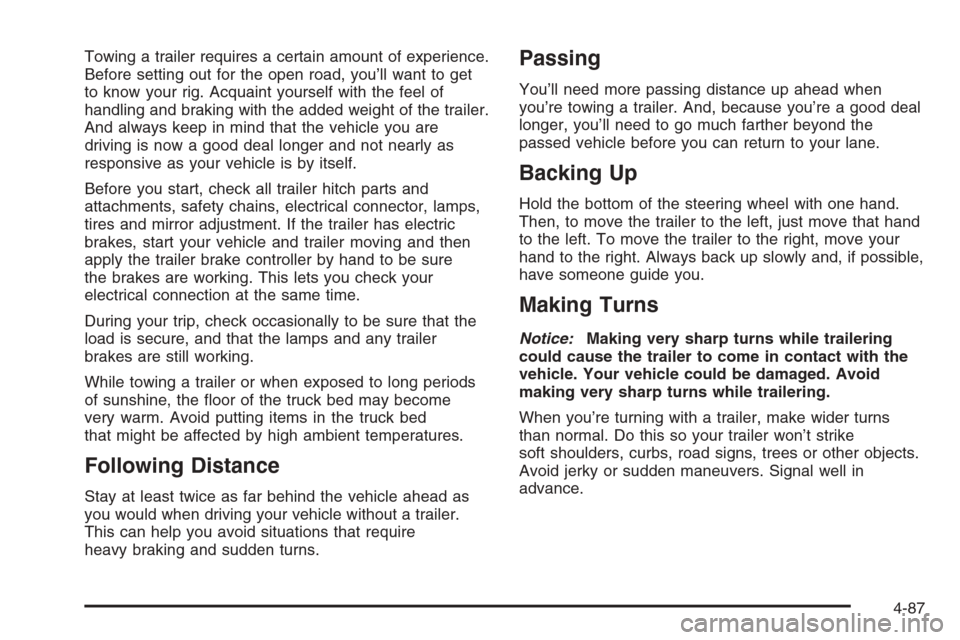
Towing a trailer requires a certain amount of experience.
Before setting out for the open road, you’ll want to get
to know your rig. Acquaint yourself with the feel of
handling and braking with the added weight of the trailer.
And always keep in mind that the vehicle you are
driving is now a good deal longer and not nearly as
responsive as your vehicle is by itself.
Before you start, check all trailer hitch parts and
attachments, safety chains, electrical connector, lamps,
tires and mirror adjustment. If the trailer has electric
brakes, start your vehicle and trailer moving and then
apply the trailer brake controller by hand to be sure
the brakes are working. This lets you check your
electrical connection at the same time.
During your trip, check occasionally to be sure that the
load is secure, and that the lamps and any trailer
brakes are still working.
While towing a trailer or when exposed to long periods
of sunshine, the �oor of the truck bed may become
very warm. Avoid putting items in the truck bed
that might be affected by high ambient temperatures.
Following Distance
Stay at least twice as far behind the vehicle ahead as
you would when driving your vehicle without a trailer.
This can help you avoid situations that require
heavy braking and sudden turns.
Passing
You’ll need more passing distance up ahead when
you’re towing a trailer. And, because you’re a good deal
longer, you’ll need to go much farther beyond the
passed vehicle before you can return to your lane.
Backing Up
Hold the bottom of the steering wheel with one hand.
Then, to move the trailer to the left, just move that hand
to the left. To move the trailer to the right, move your
hand to the right. Always back up slowly and, if possible,
have someone guide you.
Making Turns
Notice:Making very sharp turns while trailering
could cause the trailer to come in contact with the
vehicle. Your vehicle could be damaged. Avoid
making very sharp turns while trailering.
When you’re turning with a trailer, make wider turns
than normal. Do this so your trailer won’t strike
soft shoulders, curbs, road signs, trees or other objects.
Avoid jerky or sudden maneuvers. Signal well in
advance.
4-87
Page 395 of 594

Parking on Hills
{CAUTION:
You really should not park your vehicle, with a
trailer attached, on a hill. If something goes
wrong, your rig could start to move. People
can be injured, and both your vehicle and the
trailer can be damaged.
But if you ever have to park your rig on a hill, here’s
how to do it:
1. Apply your regular brakes, but don’t shift into
PARK (P) yet for an automatic transmission, or
into gear for a manual transmission.
2. Have someone place chocks under the trailer
wheels.
3. When the wheel chocks are in place, release the
regular brakes until the chocks absorb the load.
4. Reapply the regular brakes. Then apply your
parking brake and shift into PARK (P) for an
automatic transmission, or REVERSE (R) for a
manual transmission.
5. If you have a four-wheel-drive vehicle, be sure
the transfer case is in a drive gear and not in
NEUTRAL.
6. Release the regular brakes.
{CAUTION:
It can be dangerous to get out of your vehicle
if the automatic transmission shift lever is not
fully in PARK (P) with the parking brake �rmly
set. Your vehicle can roll.
If you have left the engine running, the vehicle
can move suddenly. You or others could be
injured. To be sure your vehicle will not move,
even when you are on fairly level ground, use
the steps that follow.
Always put the automatic transmission shift
lever fully in PARK (P) with the parking brake
�rmly set. If you have a manual transmission,
turn the engine off and �rmly set the parking
brake.
If the transfer case on four-wheel-drive
vehicles is in NEUTRAL, your vehicle will
be free to roll, even if your automatic
transmission shift lever is in PARK (P).
So, be sure the transfer case is in a drive
gear — not in NEUTRAL.
4-89